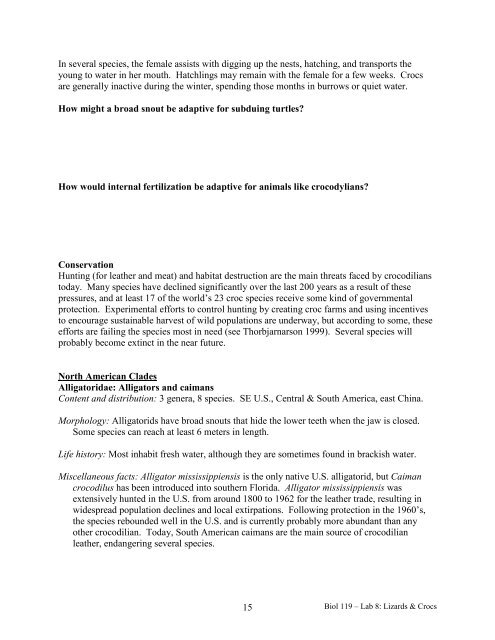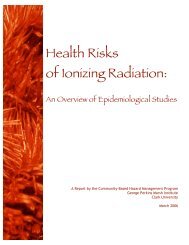Biol 119 – Herpetology Lab 8: Lizard and ... - Clark University
Biol 119 – Herpetology Lab 8: Lizard and ... - Clark University
Biol 119 – Herpetology Lab 8: Lizard and ... - Clark University
You also want an ePaper? Increase the reach of your titles
YUMPU automatically turns print PDFs into web optimized ePapers that Google loves.
In several species, the female assists with digging up the nests, hatching, <strong>and</strong> transports the<br />
young to water in her mouth. Hatchlings may remain with the female for a few weeks. Crocs<br />
are generally inactive during the winter, spending those months in burrows or quiet water.<br />
How might a broad snout be adaptive for subduing turtles?<br />
How would internal fertilization be adaptive for animals like crocodylians?<br />
Conservation<br />
Hunting (for leather <strong>and</strong> meat) <strong>and</strong> habitat destruction are the main threats faced by crocodilians<br />
today. Many species have declined significantly over the last 200 years as a result of these<br />
pressures, <strong>and</strong> at least 17 of the world’s 23 croc species receive some kind of governmental<br />
protection. Experimental efforts to control hunting by creating croc farms <strong>and</strong> using incentives<br />
to encourage sustainable harvest of wild populations are underway, but according to some, these<br />
efforts are failing the species most in need (see Thorbjarnarson 1999). Several species will<br />
probably become extinct in the near future.<br />
North American Clades<br />
Alligatoridae: Alligators <strong>and</strong> caimans<br />
Content <strong>and</strong> distribution: 3 genera, 8 species. SE U.S., Central & South America, east China.<br />
Morphology: Alligatorids have broad snouts that hide the lower teeth when the jaw is closed.<br />
Some species can reach at least 6 meters in length.<br />
Life history: Most inhabit fresh water, although they are sometimes found in brackish water.<br />
Miscellaneous facts: Alligator mississippiensis is the only native U.S. alligatorid, but Caiman<br />
crocodilus has been introduced into southern Florida. Alligator mississippiensis was<br />
extensively hunted in the U.S. from around 1800 to 1962 for the leather trade, resulting in<br />
widespread population declines <strong>and</strong> local extirpations. Following protection in the 1960’s,<br />
the species rebounded well in the U.S. <strong>and</strong> is currently probably more abundant than any<br />
other crocodilian. Today, South American caimans are the main source of crocodilian<br />
leather, endangering several species.<br />
15<br />
<strong>Biol</strong> <strong>119</strong> <strong>–</strong> <strong>Lab</strong> 8: <strong>Lizard</strong>s & Crocs
















